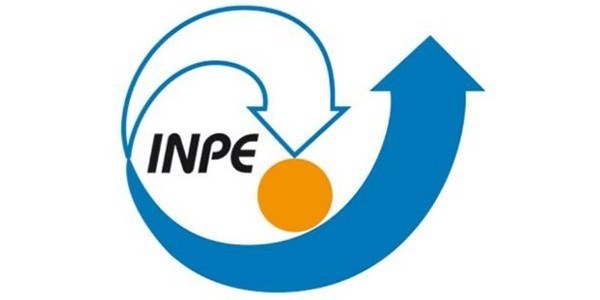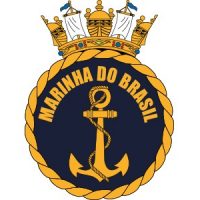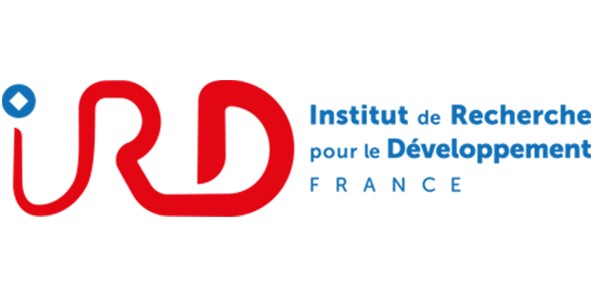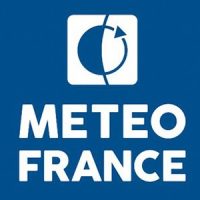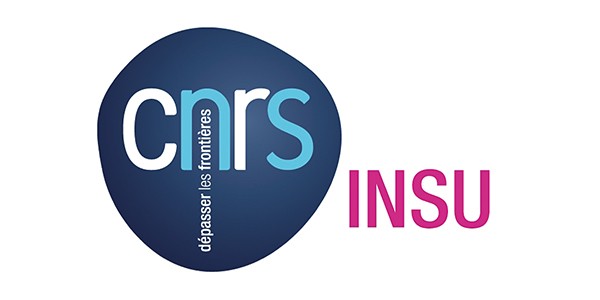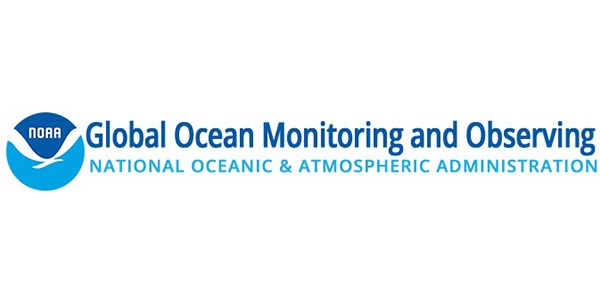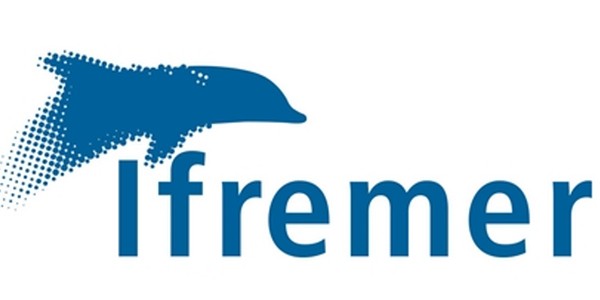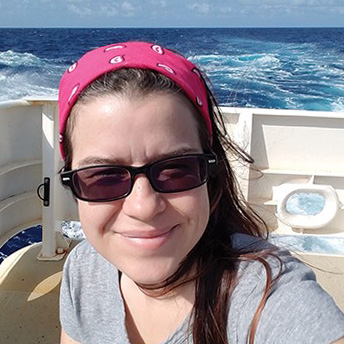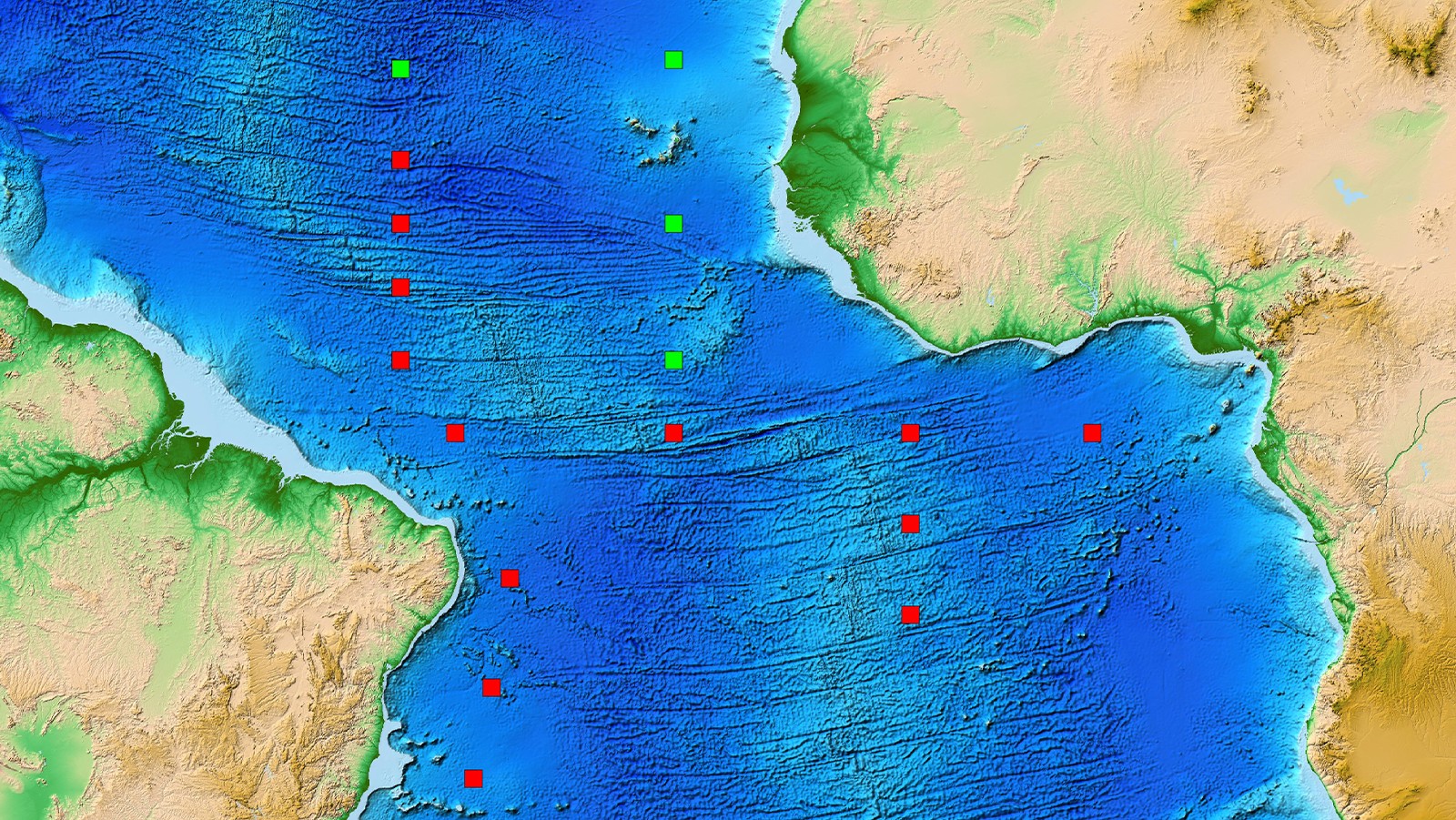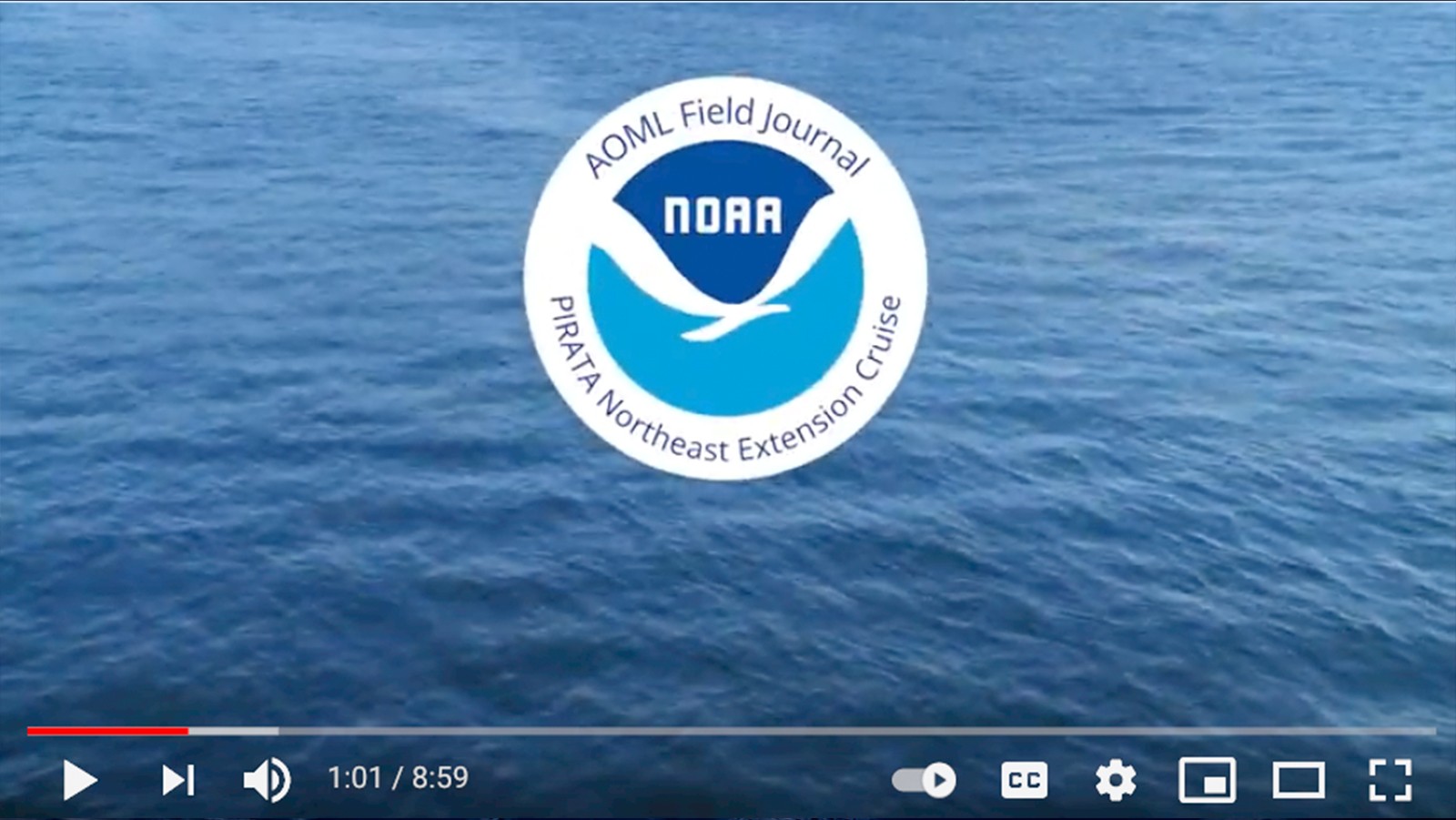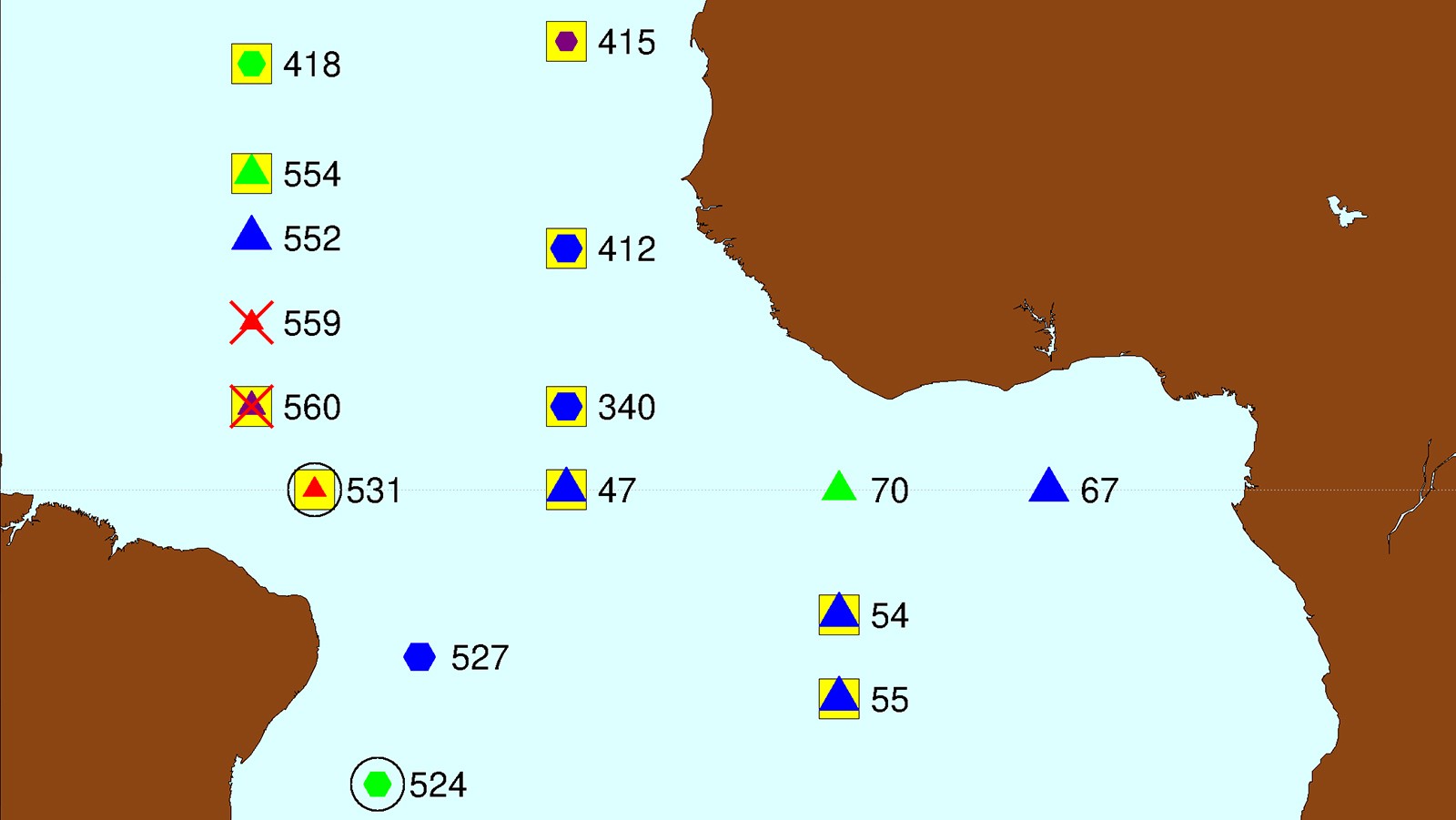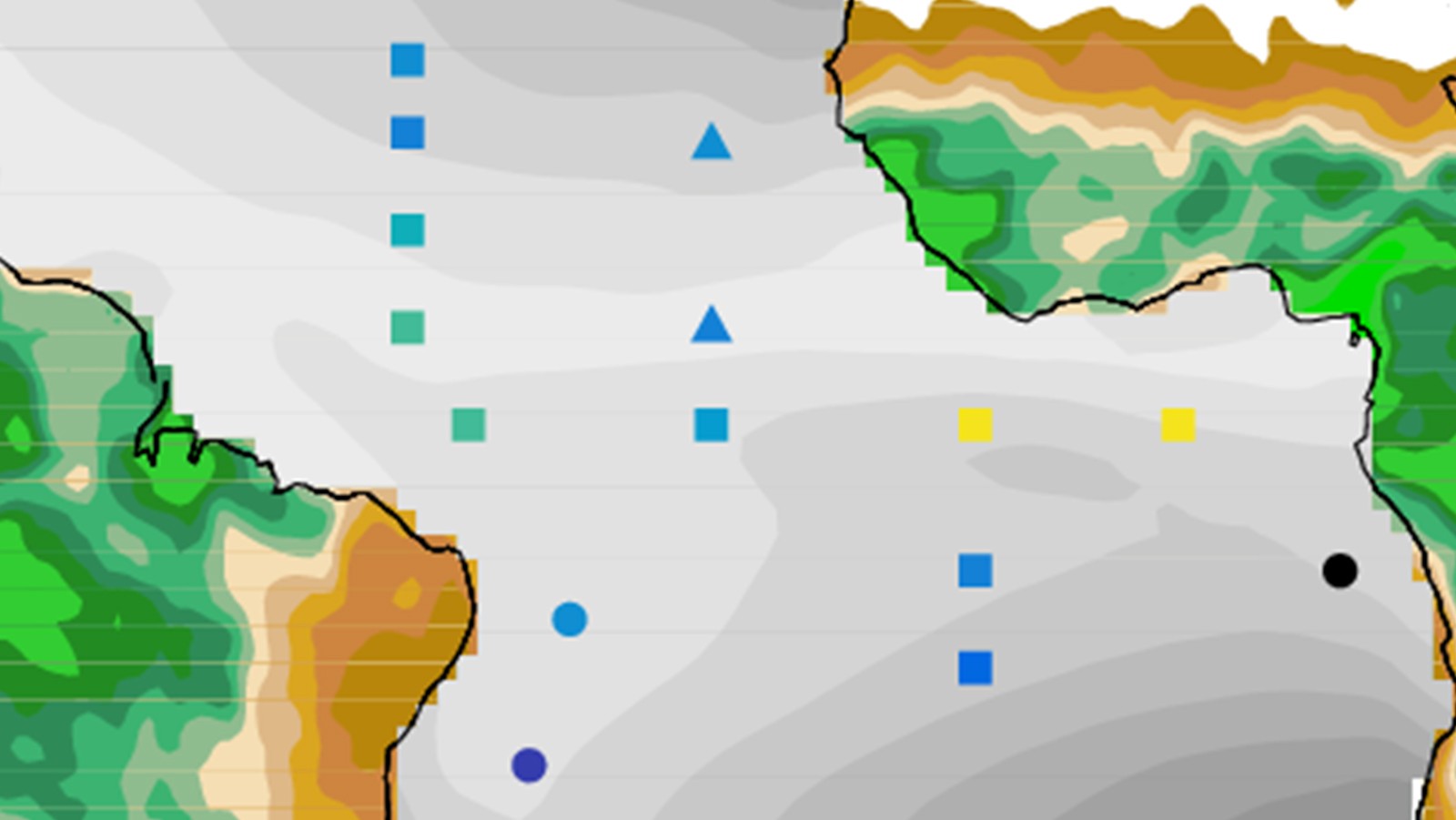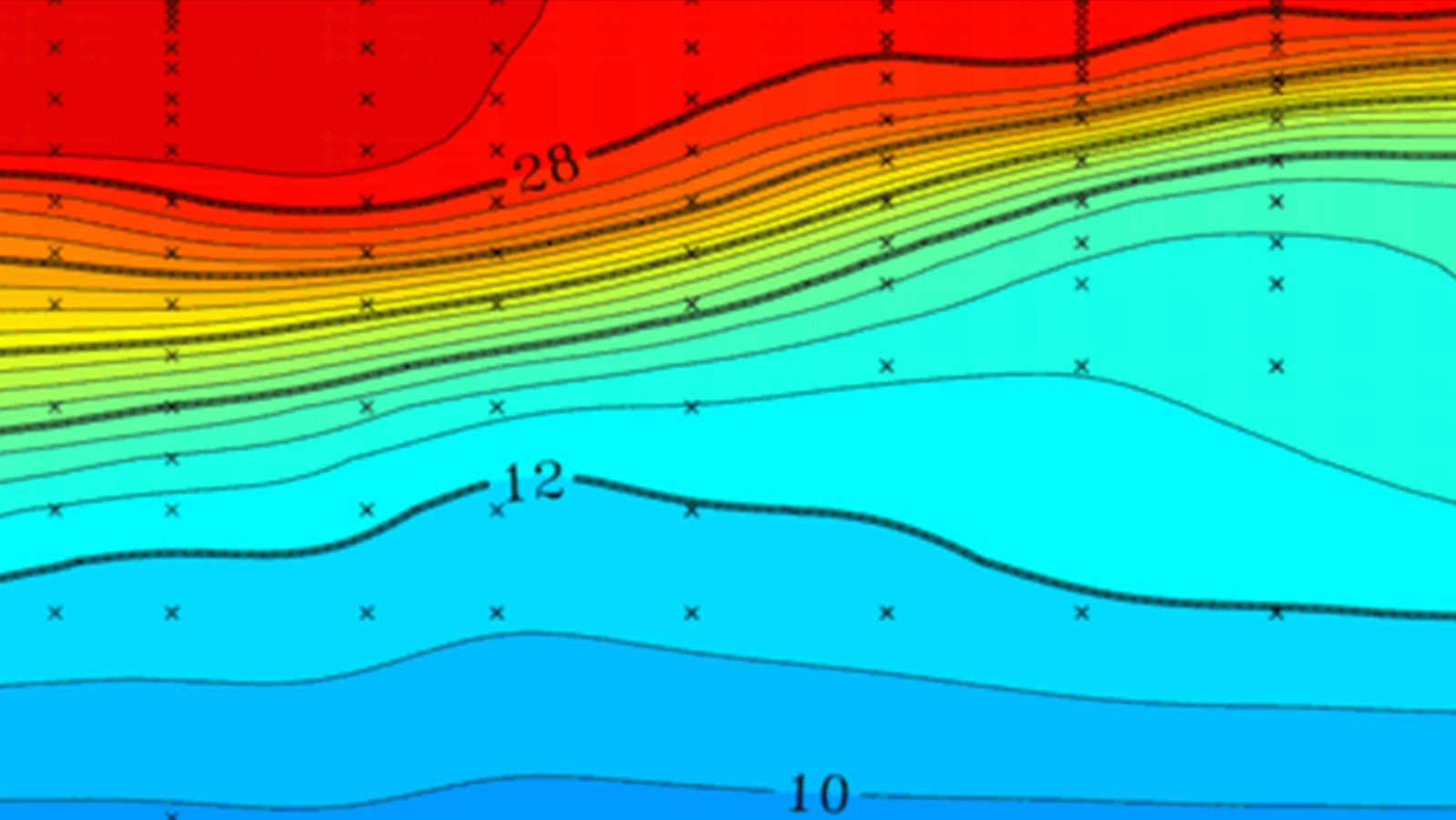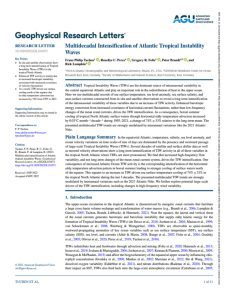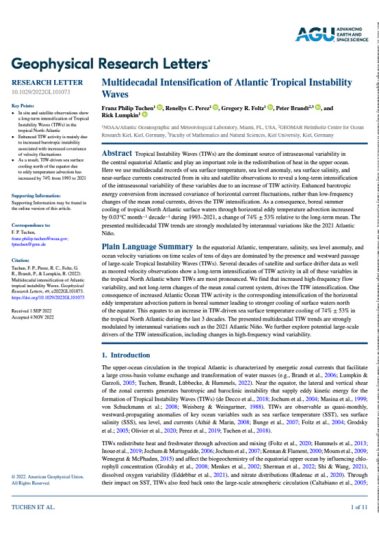PIRATA Northeast Extension
Tropical Atlantic Observations for Weather & Climate
JUMP TO DATA
OR SCROLL TO LEARN MORE
Who We Are
PIRATA, the Prediction and Research Moored Array in the Tropical Atlantic, is a multinational observation network, established to improve our knowledge and understanding of ocean-atmosphere variability in the tropical Atlantic. It is a joint project between Brazil, France, and the United States of America. PIRATA is motivated by fundamental scientific issues and by societal needs for improved prediction of weather and climate variability, and their impacts on the countries surrounding the tropical Atlantic basin. The overarching goals of the project are below.
Our Objectives
1. Improve the description of sub-seasonal to interannual variability in the atmospheric and oceanic boundary layers of the tropical Atlantic Ocean.
2. Improve our understanding of the relative contributions of air-sea fluxes and ocean dynamics to variability in sea surface temperature, salinity, and sub-surface heat content.
3. Provide a set of data useful for developing and improving predictive models of the coupled ocean-atmosphere system and validate satellite data.
4. Document interactions between tropical Atlantic climate and variability outside the region, such as El Niño and the North Atlantic Oscillation.
5. Design, deploy, and maintain an array of moored oceanic buoys and collect and transmit a set of oceanic and atmospheric data, via satellite in near-real time, to monitor and study the upper ocean and atmosphere of the tropical Atlantic Ocean.
| Gregory Foltz, Ph.D.
AOML Lead Principal Investigator
| Renellys Perez, Ph.D.
Co-Principal Investigator
Read More News
Research Impacts & Key Findings
AOML has led 16 PIRATA Northeast Extension cruises from 2006 to 2022, with 713 hydrographic casts, 1369 XBTs deployed, 191 drifters, and 125 Argo floats deployed.
Over 393 peer-reviewed publications have used PIRATA mooring and cruise data.
PIRATA has collected over 26 years of data in the tropical Atlantic, and PIRATA Northeast Extension has collected over 17 years of data.
Background
Introduction
Air-sea interactions have a large impact on weather and climate variability and can be a determining factor in the prediction of extreme weather and ocean changes. In the tropical Atlantic, these interactions influence development of droughts, floods, marine heat waves, severe tropical storms and hurricanes, and fisheries landings, with direct impacts in the Americas and Africa.
About PIRATA
The Prediction and Research Moored Array in the Tropical Atlantic (PIRATA) is an multinational network of ocean buoys that serves as the backbone of the integrated tropical Atlantic observing system. PIRATA allows for the collection of scientific data to improve our knowledge and understanding of ocean-atmosphere variability in the tropical Atlantic, validate satellite observations, and provide data for weather and ocean models. PIRATA is a joint project between Brazil, France, and the United States of America.
From Pilot to Prediction
PIRATA was first established in the mid-1990s and has undergone expansions and enhancements since 2005 to improve its utility for ocean and climate research and forecasting. To reflect these improvements in design, the original PIRATA acronym was changed in 2008 from “Pilot Research Moored Array in the Tropical Atlantic” to “Prediction and Research Moored Array in the Tropical Atlantic.” PIRATA is supported by France (IRD, Meteo-France, CNRS and IFREMER), Brazil (INPE and DHN), and the USA (NOAA). AOML contributes to the PIRATA program by leading cruises and collecting shipboard measurements which are used by our sister lab, the Pacific Marine Environmental Laboratory (PMEL) in Seattle, to calibrate the mooring data. PMEL is responsible for servicing, maintaining, and deploying the moorings and making the mooring data available in near-real-time.
Northeast Extension & The Tropical North Atlantic
AOML’s field work contribution to the PIRATA program is focused on the PIRATA Northeast Extension (PNE). PNE is a joint project between AOML and PMEL to expand the set of tropical moored buoys into the northern and northeastern sectors of the Tropical Atlantic Ocean. The tropical North Atlantic is a region of strong climate variations from intraseasonal to decadal scales, with impacts on rainfall rates and storm strikes in the surrounding regions of Africa and the Americas. Important processes in this region include formation of Cape-Verde type Atlantic hurricanes, of which Irma and Florence are recent examples, seasonal migration of the Intertropical Convergence Zone (ITCZ) and the Guinea Dome, interannual variations of the ITCZ migration associated with rainfall anomalies in Africa and the Americas, off-equatorial eddy heat advection and turbulent cooling by tropical instability waves, and overturning-related ventilation of the oxygen minimum zone. Due to the significance of these processes, the northeast extension was added to the existing array in 2006.
Mooring Array
Implementation of PIRATA started in 1997 with an array of backbone moored buoys in the Atlantic (Servain et al., 1998), similar to the Tropical Atmosphere-Ocean (TAO) array used to study ENSO variability in the equatorial Pacific (McPhaden et al., 1998).
Starting in late 2005, extensions were added to the backbone array in key regions, including the US-led PIRATA Northeast Extension (PNE) in the climate-critical tropical North Atlantic (Bourles et al., 2008; Bourles et al. 2019; Foltz et al. 2019). The current configuration of the PIRATA array is shown below. The orange symbols represent the PNE moorings.
Complimentary Projects
Featured Project.
Tropical Atlantic Current Observations Study (TACOS)
TACOS is a pilot study focused on advancing understanding of ocean circulation and mixing and its impact on sea surface temperatures and the atmosphere. Using acoustic current meters augmented to the existing NOAA PIRATA Northeast Extension 4°N 23°W mooring, TACOS provides a novel time series of a horizontal velocity and its vertical shear in regions with strong ocean-atmosphere coupling on weather and climate timescales.
By establishing a long-term time series of current observations at 4°N 23°W, we can better understand how ocean currents, vertical shear, advection, and mixing can modify SSTs and overlying atmospheric processes. Additionally, TACOS observations can be used to validate tropical weather models and forecasts, which presently rely on lower resolution ocean measurements.
To learn more about the TACOS project at AOML, visit its project page.
Science Seminar
The Tropical Atlantic Observing System
Project Highlight
PIRATA Field Journal: Come Sail Away
On February 24, 2021 researchers with AOML returned to land, docking in Key West after nearly six weeks aboard the NOAA ship Ronald H. Brown. The scientists were at sea for the PIRATA Northeast Extension (PNE) 2021 cruise. Diego Ugaz, an University of Miami Cooperative Institute technician, served as the Night Watch Leader for this cruise. Diego recorded his time aboard the ship and provided a look into his daily life at sea. This successful mission will ensure that the PNE buoys continue to effectively and accurately collect data to better understand ocean-atmosphere variability in the tropical Atlantic region.
Featured StoryMap
NOAA-led Cruise Expands Sensors for Climate Prediction
Follow along with scientists at AOML as they travel from St. Petersburg, FL to Praia, Cape Verde to service and collect data from ocean buoys in support of the PIRATA Northeast Extension project. PIRATA buoys provide critical data that are used to develop and improve predictive models of the Atlantic climate system, as well as used for ocean and weather prediction.
Photos from the Field
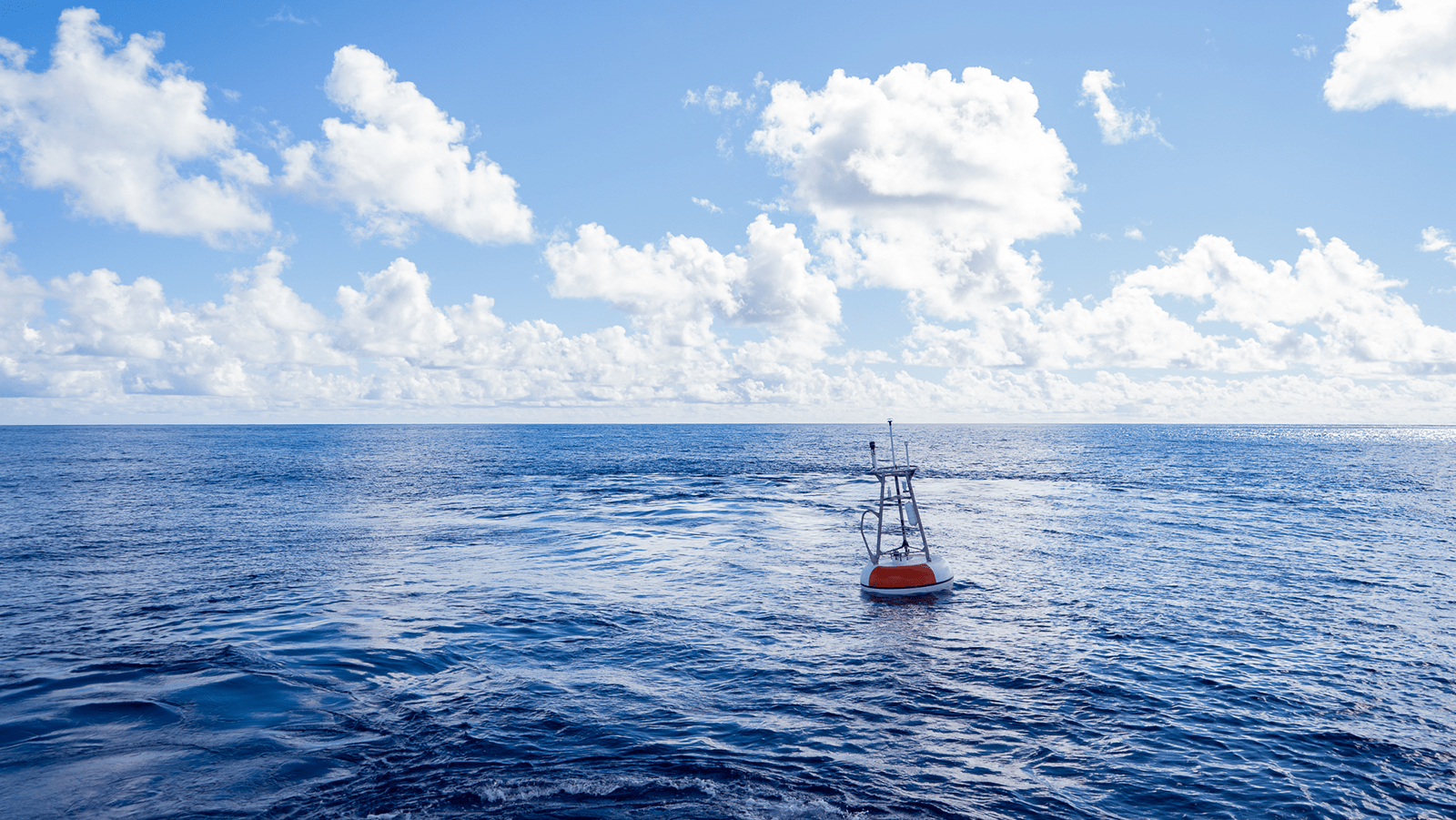
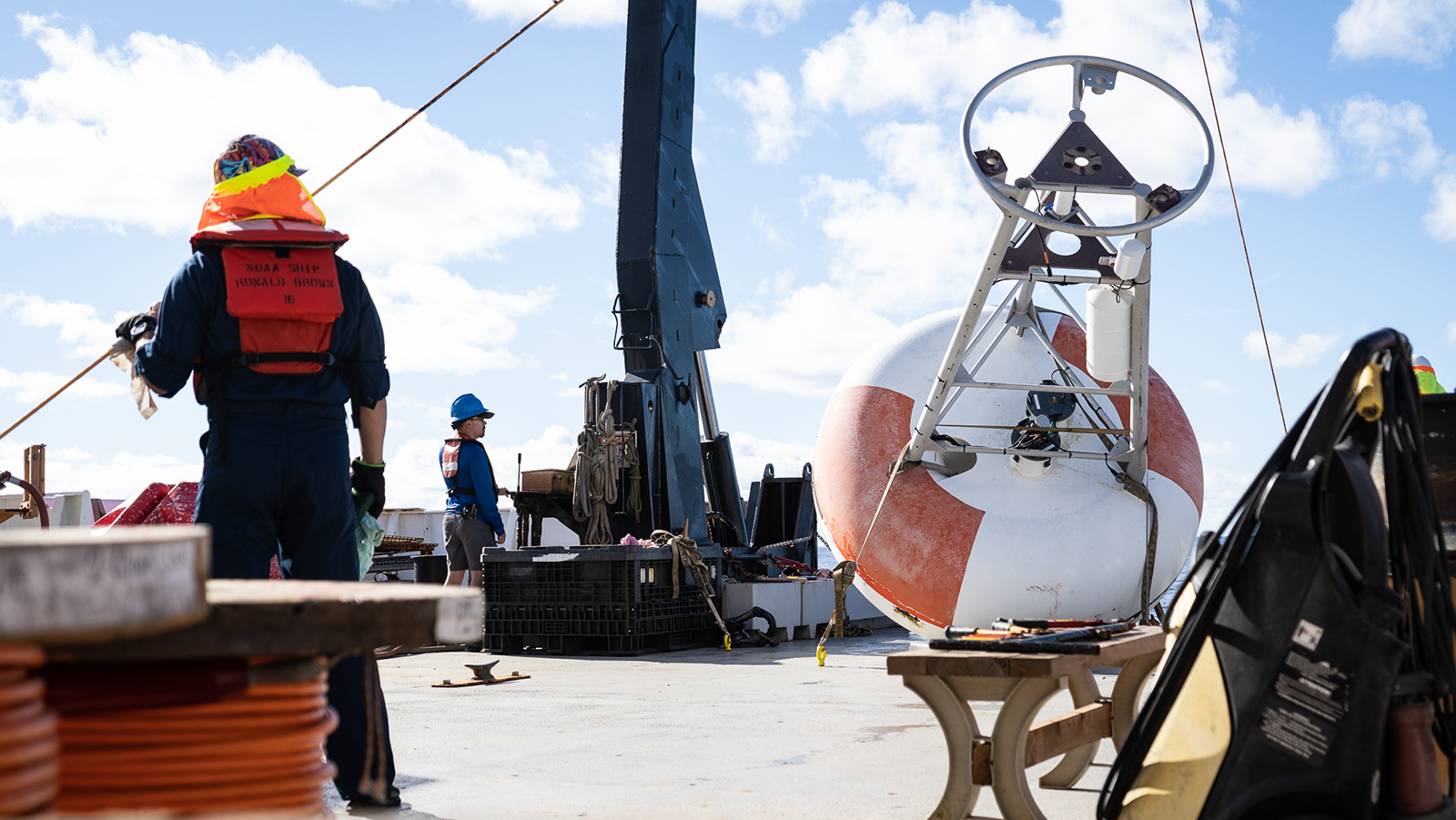
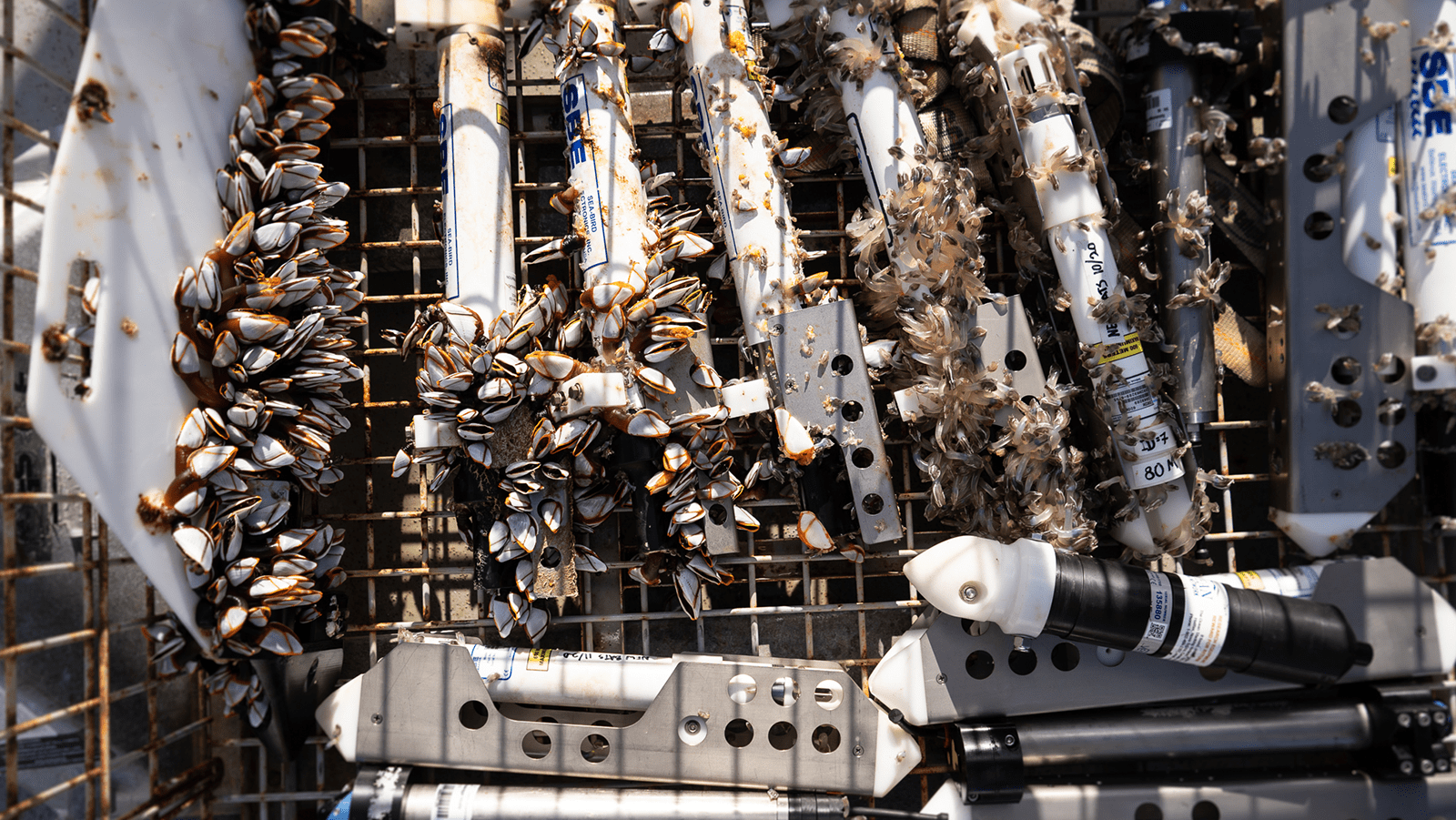
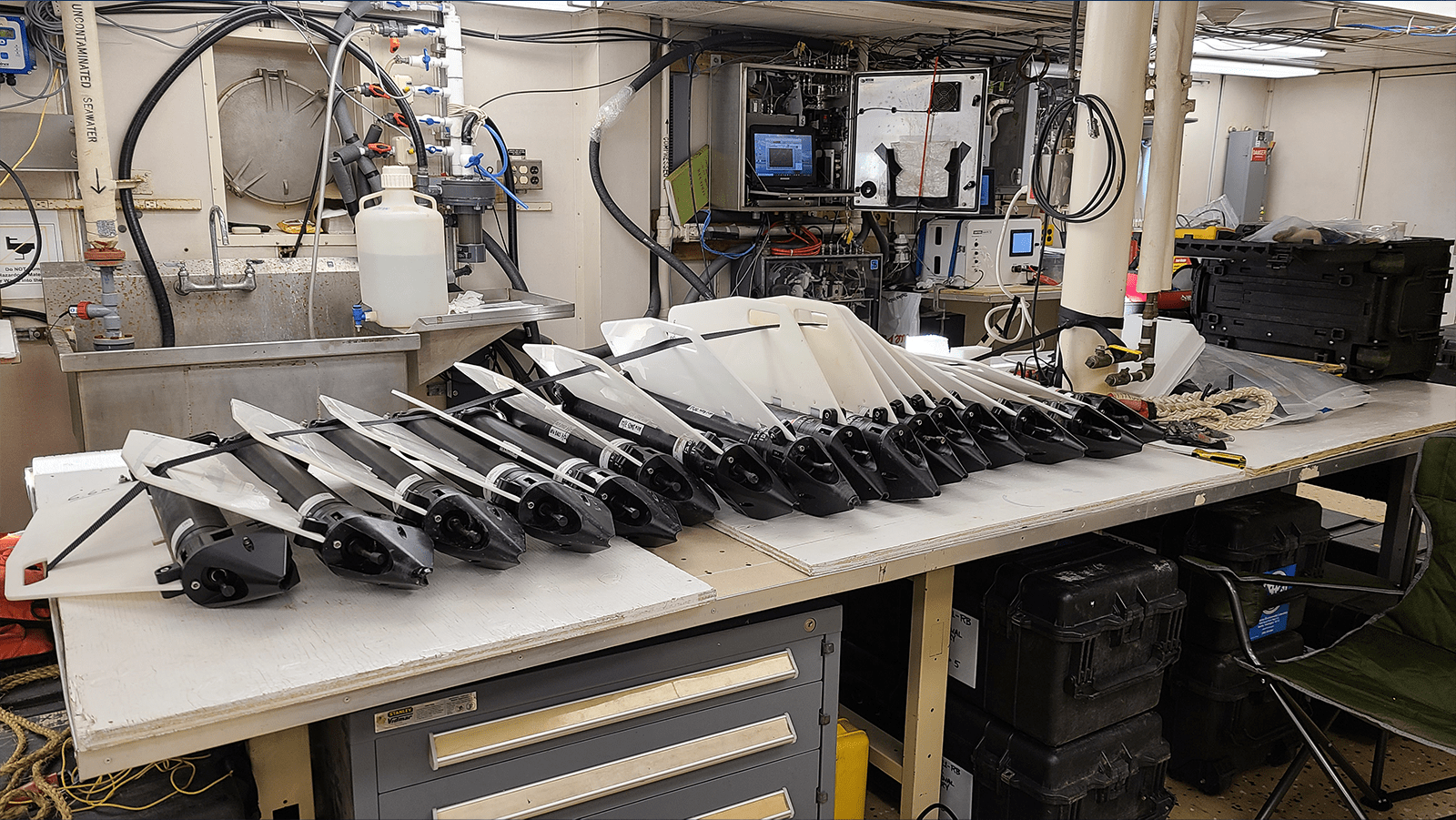
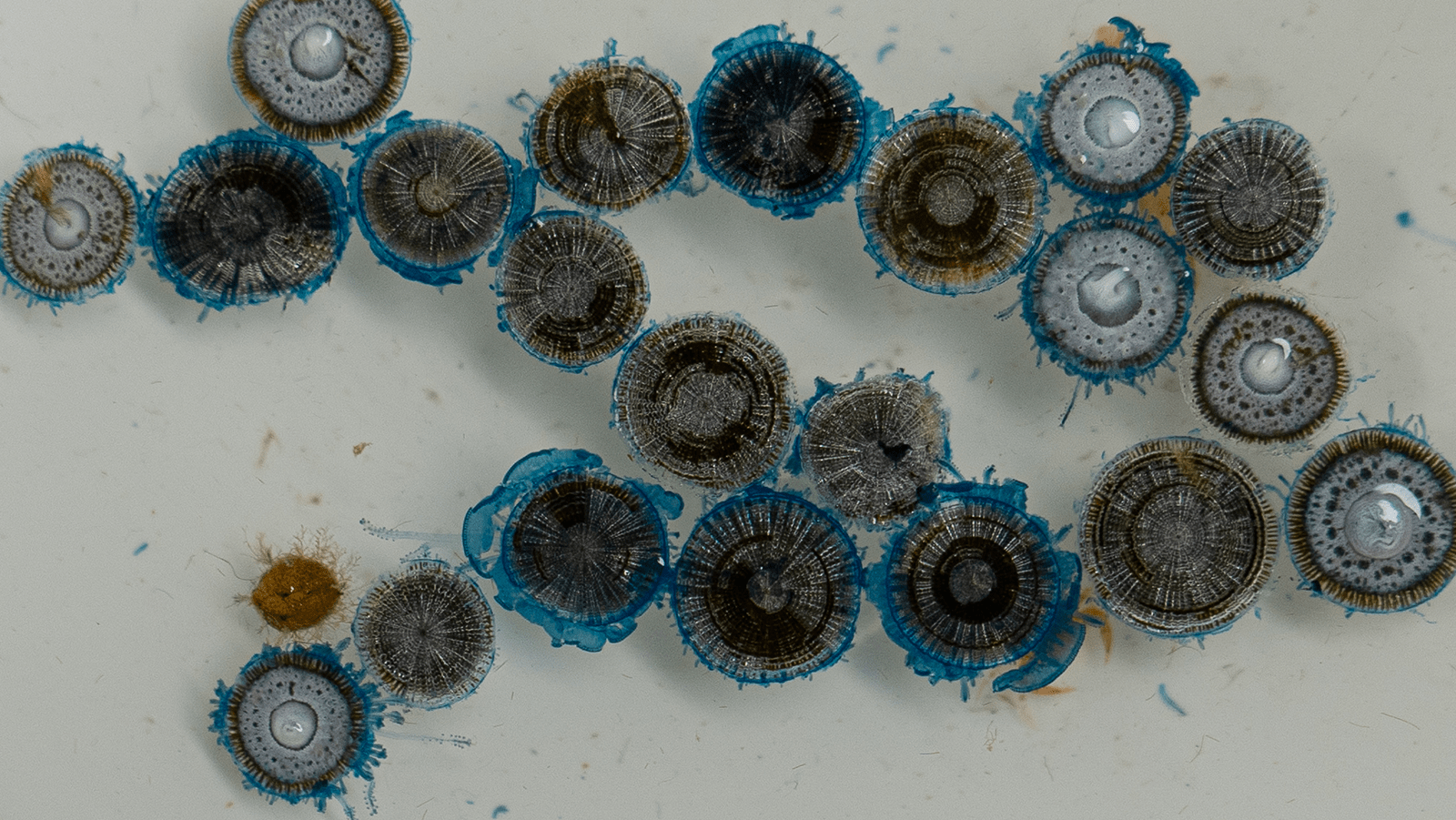
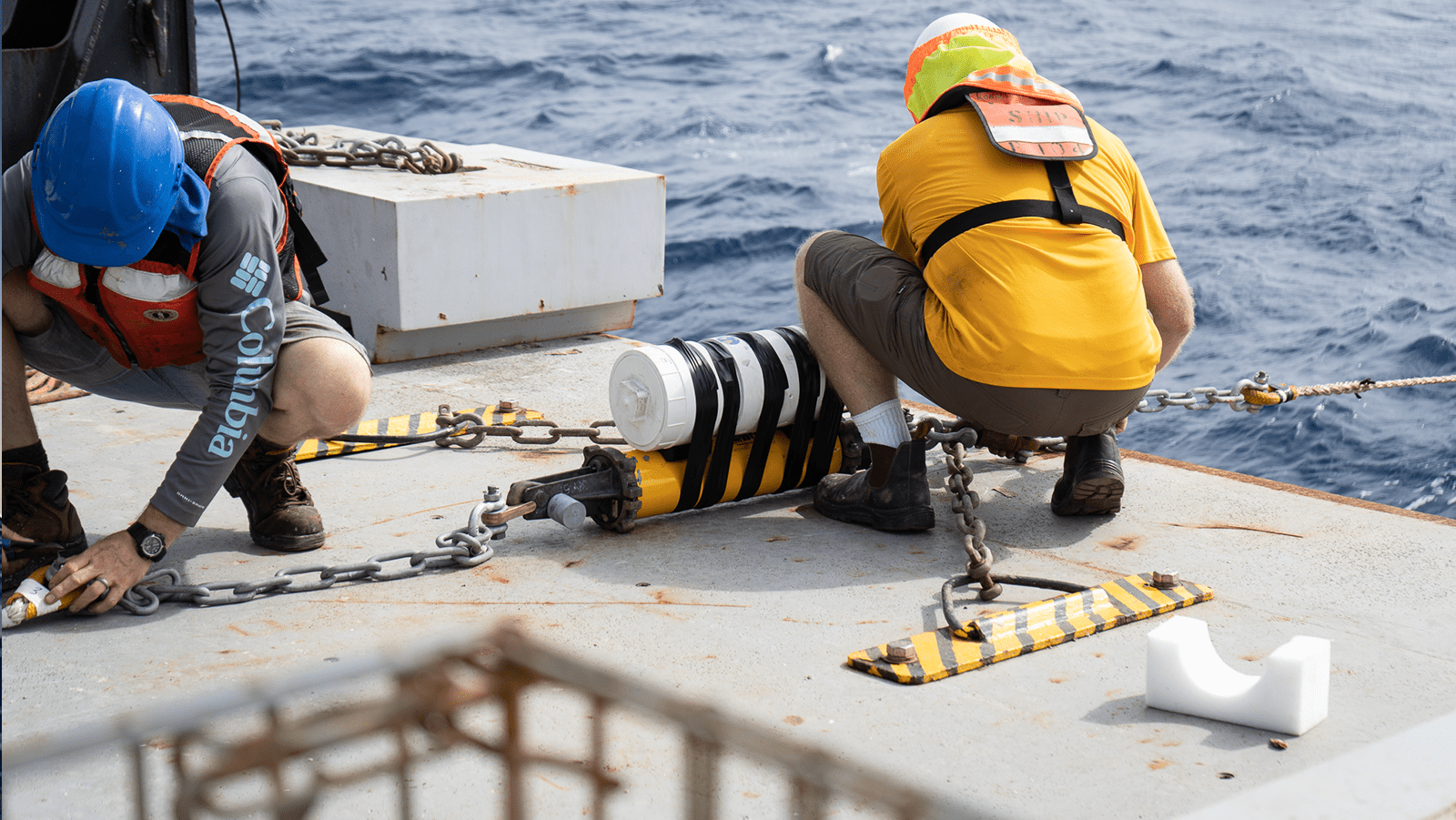
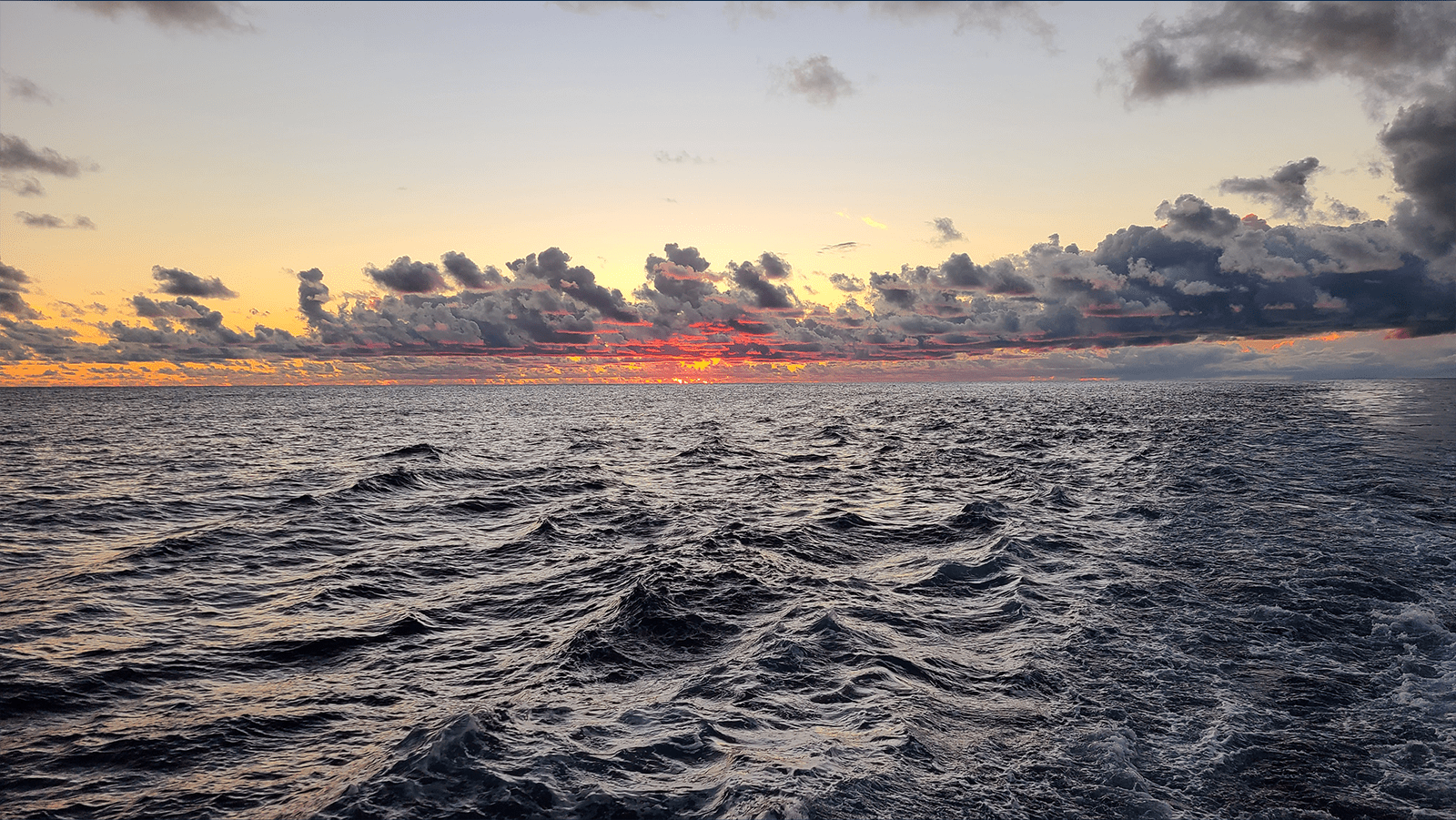
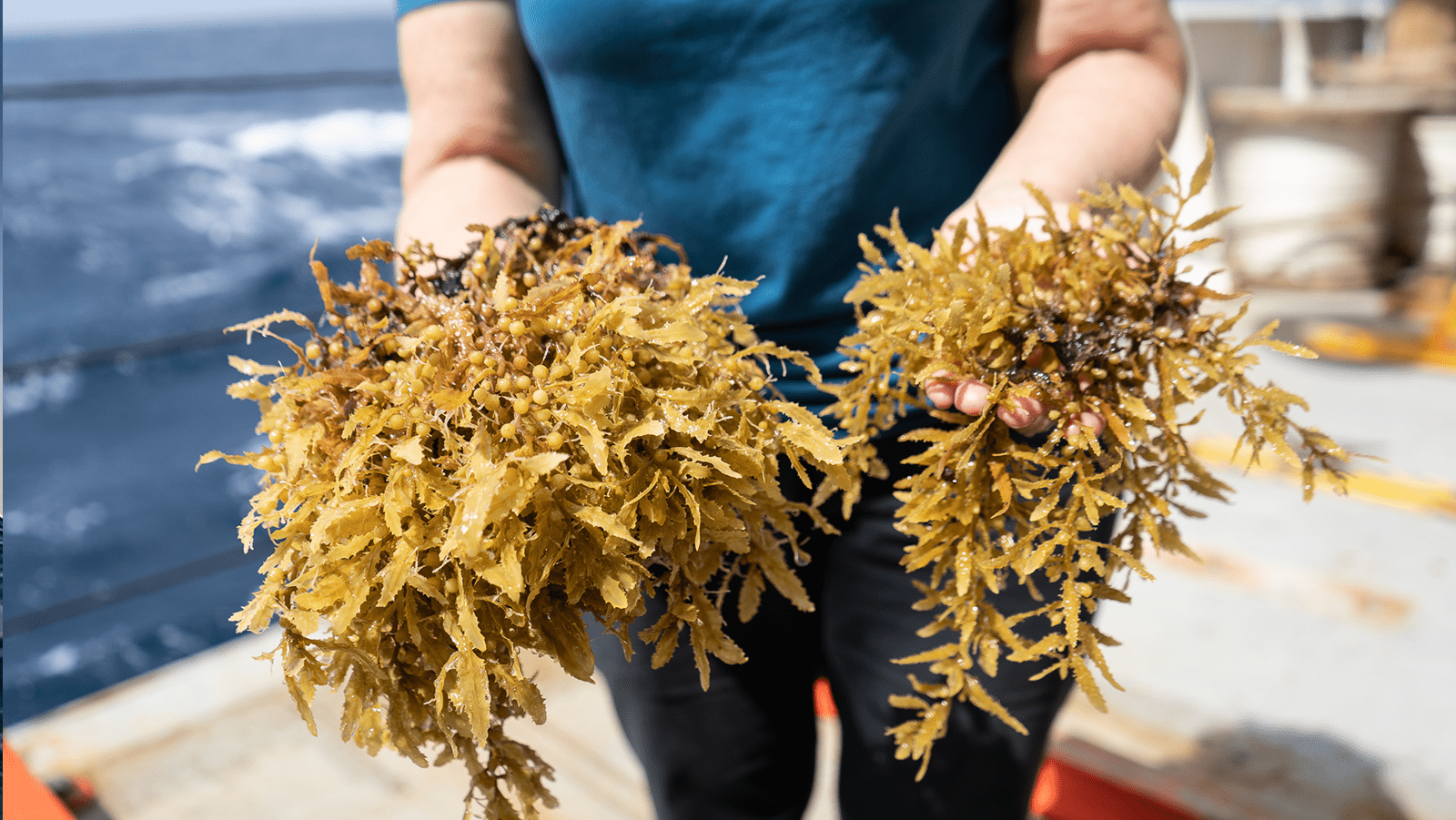
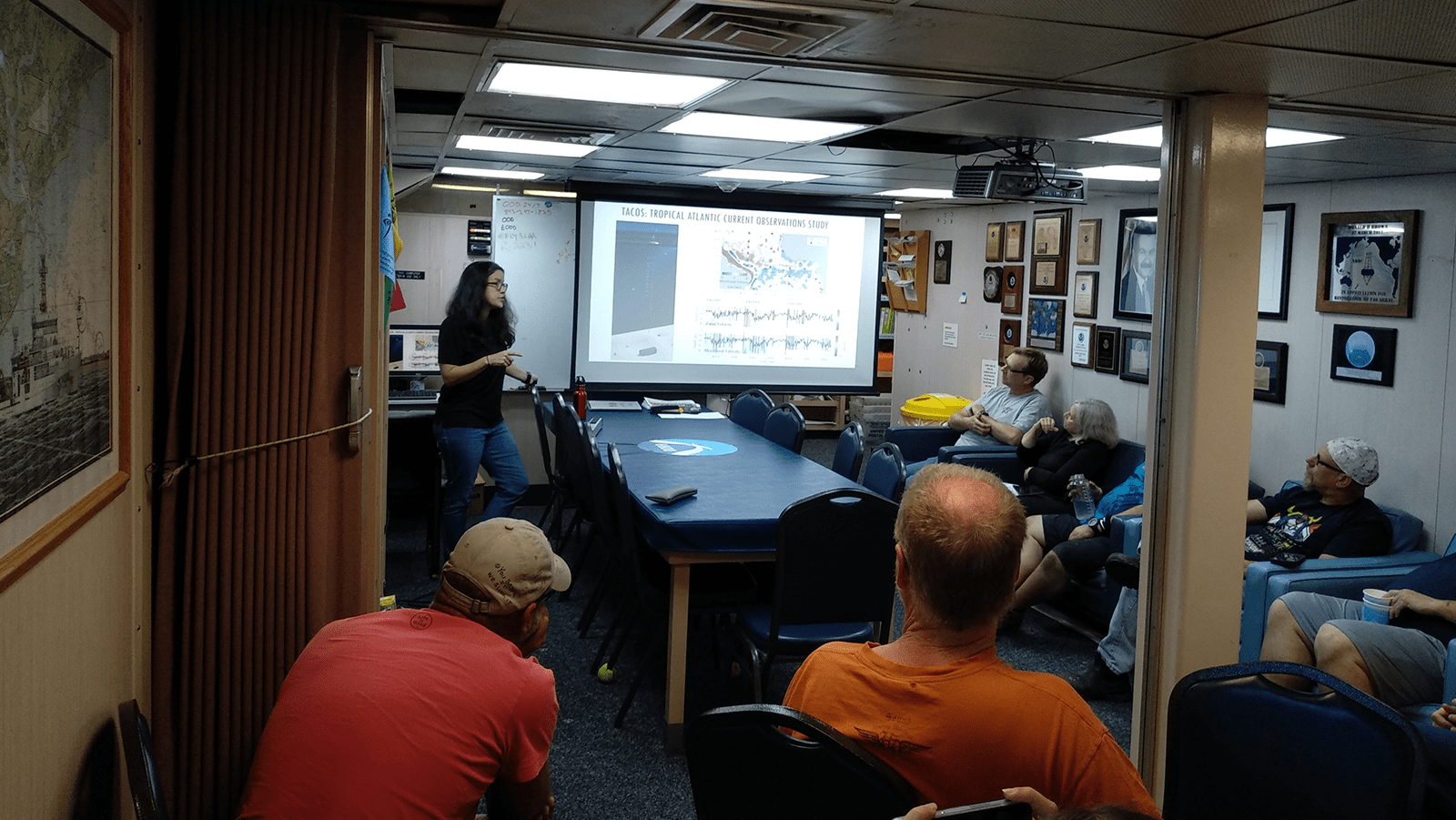
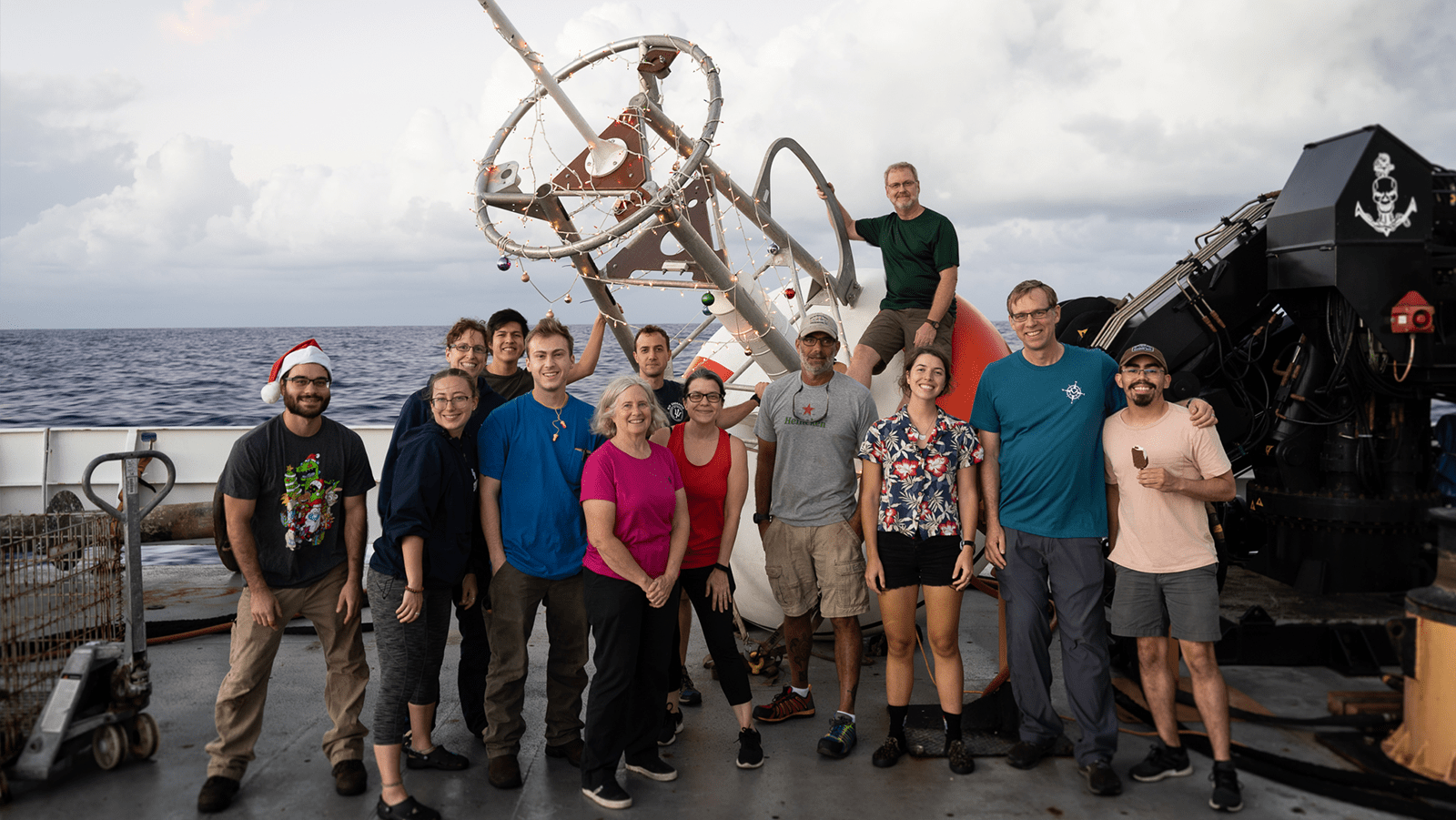
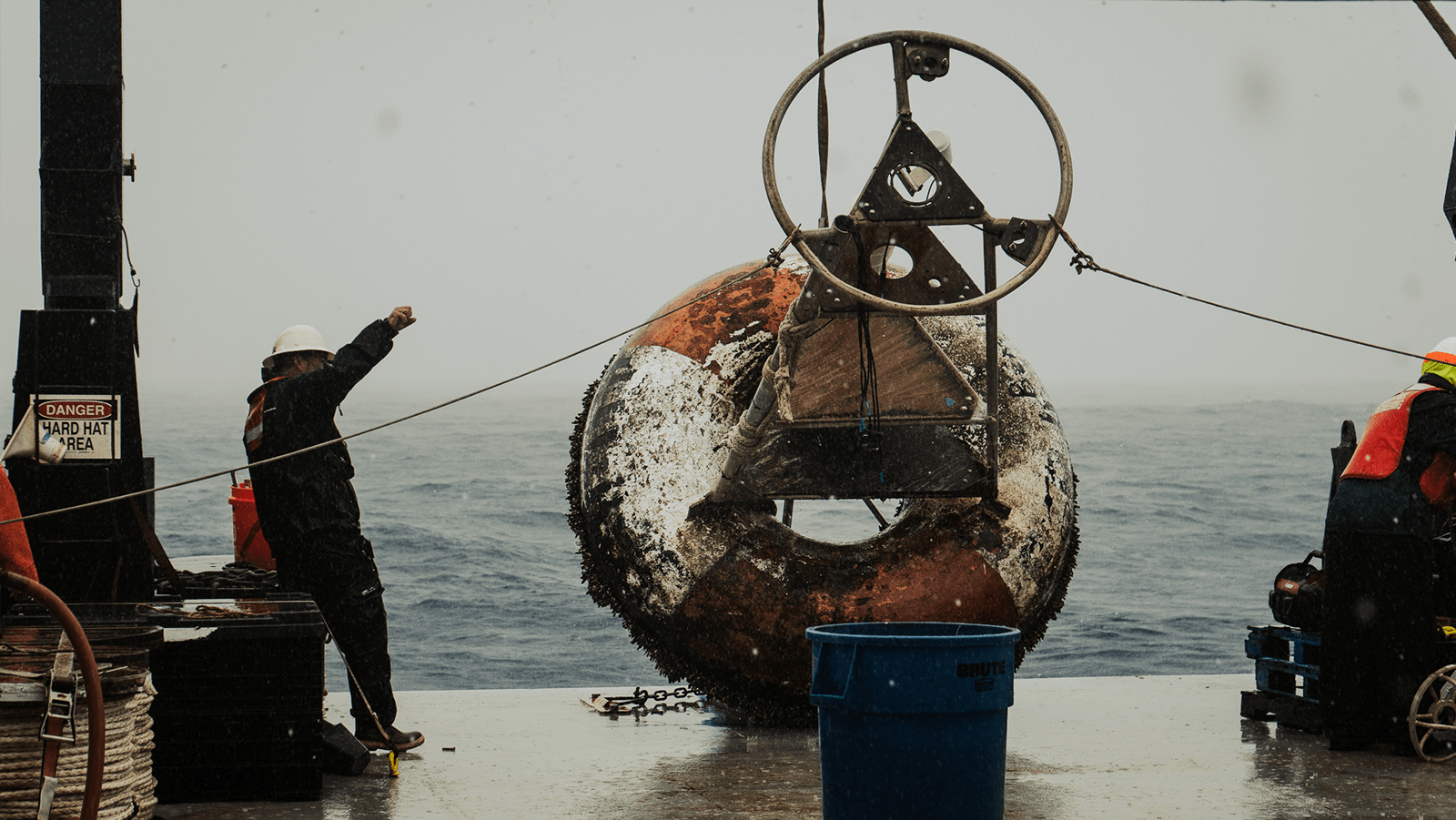
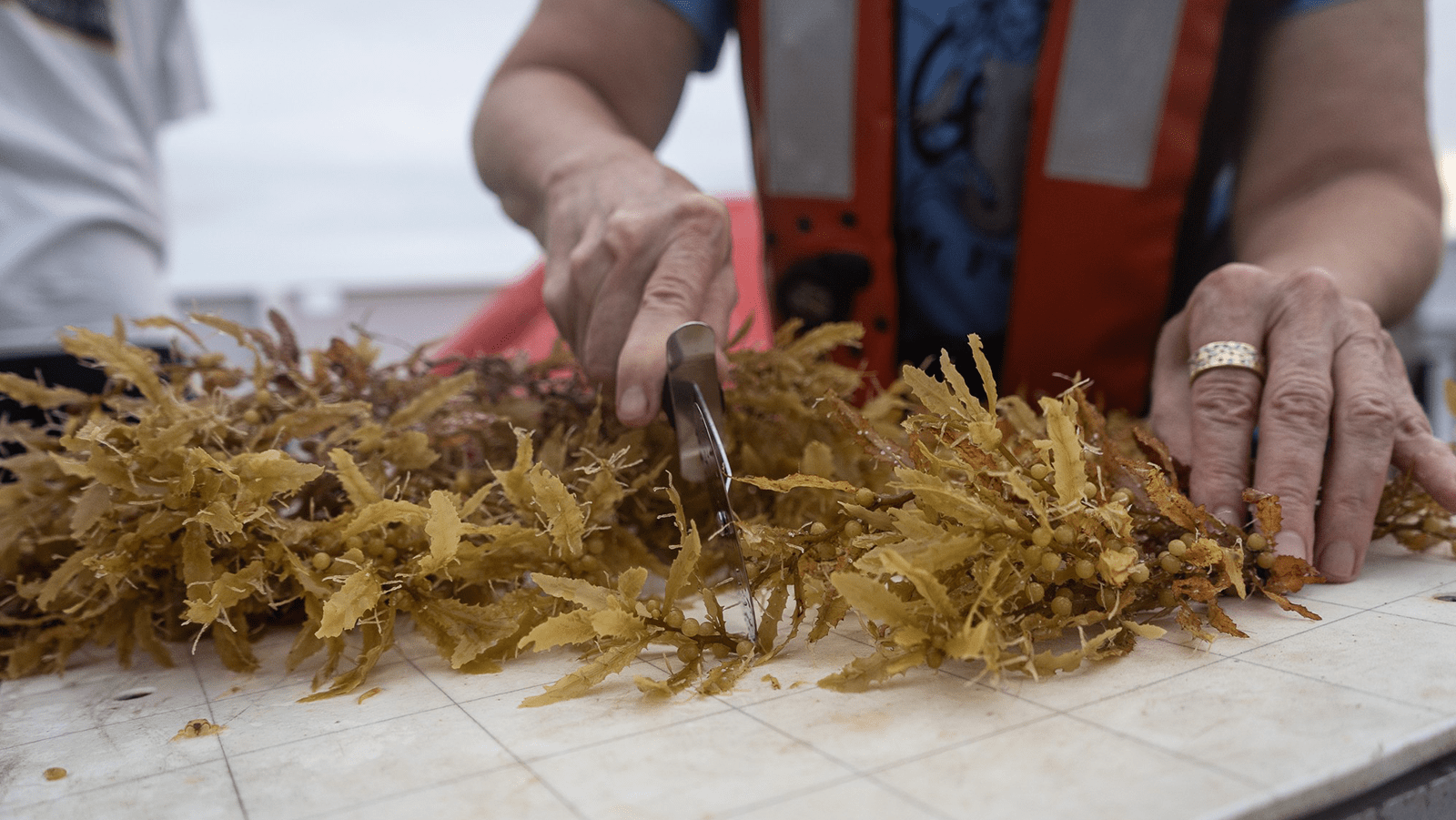
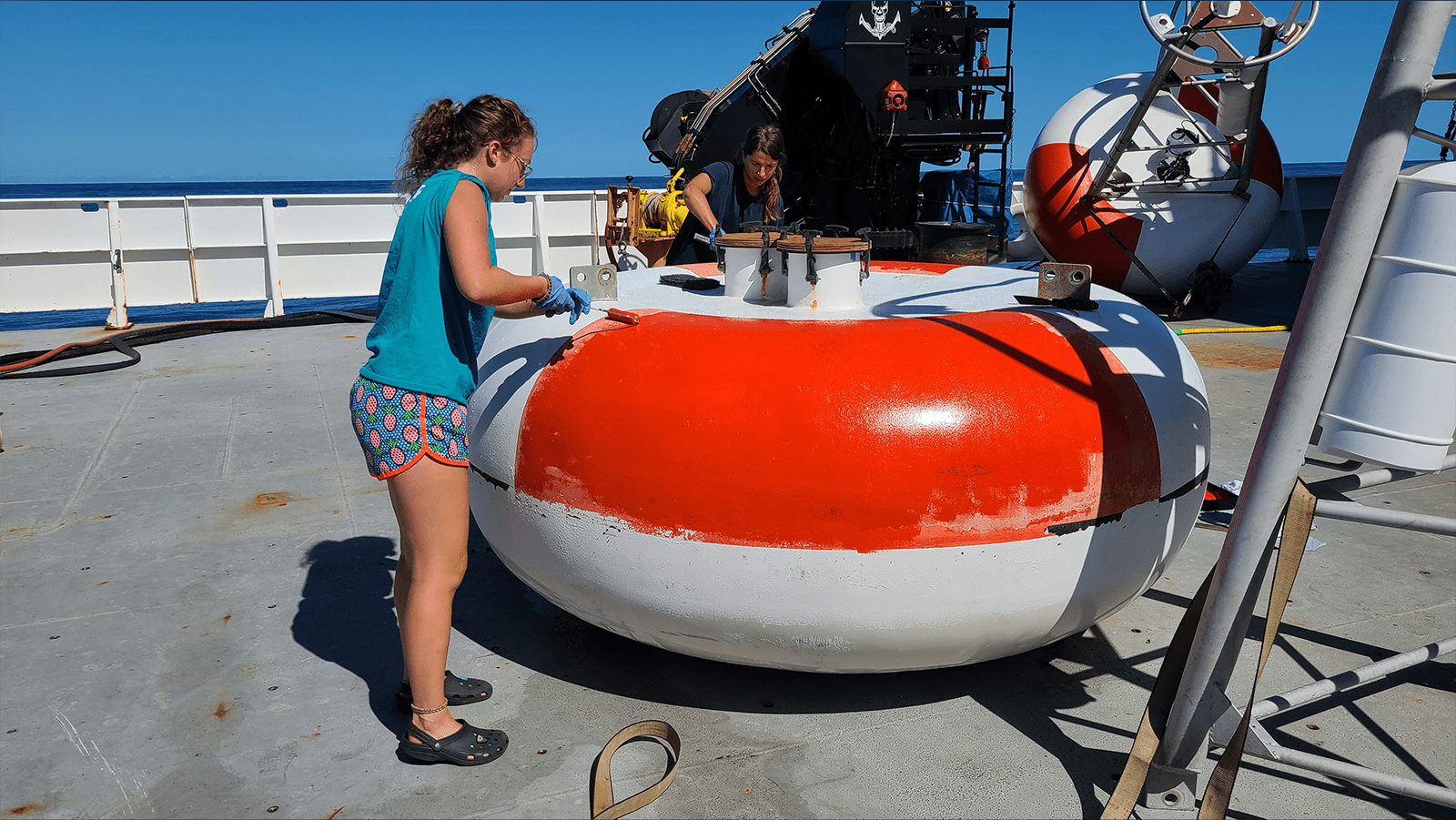
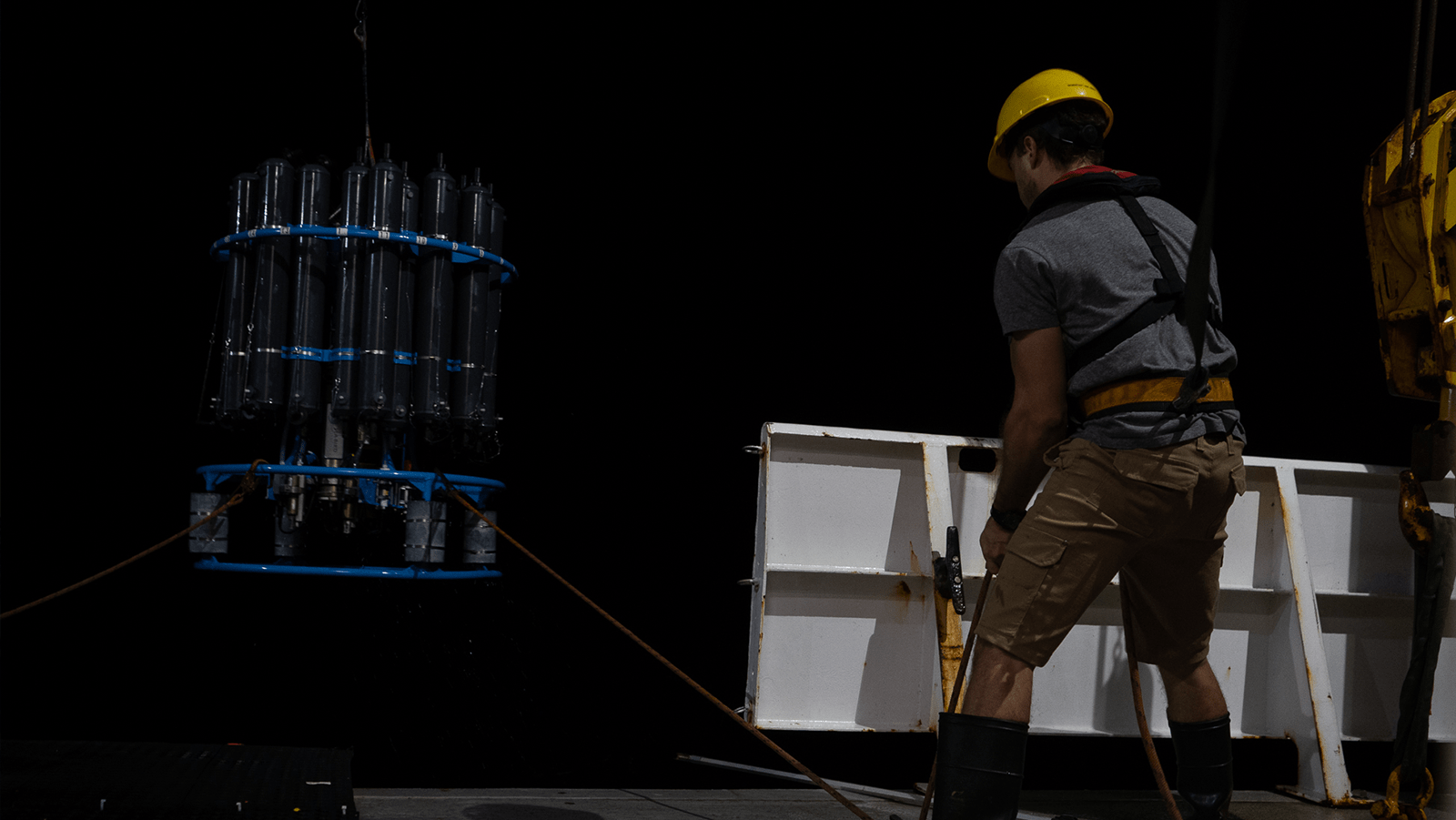














pnedata anchor
Data
Past Cruise Data
Click on each date below to see its corresponding data and report.
November 1 - December 9, 2022
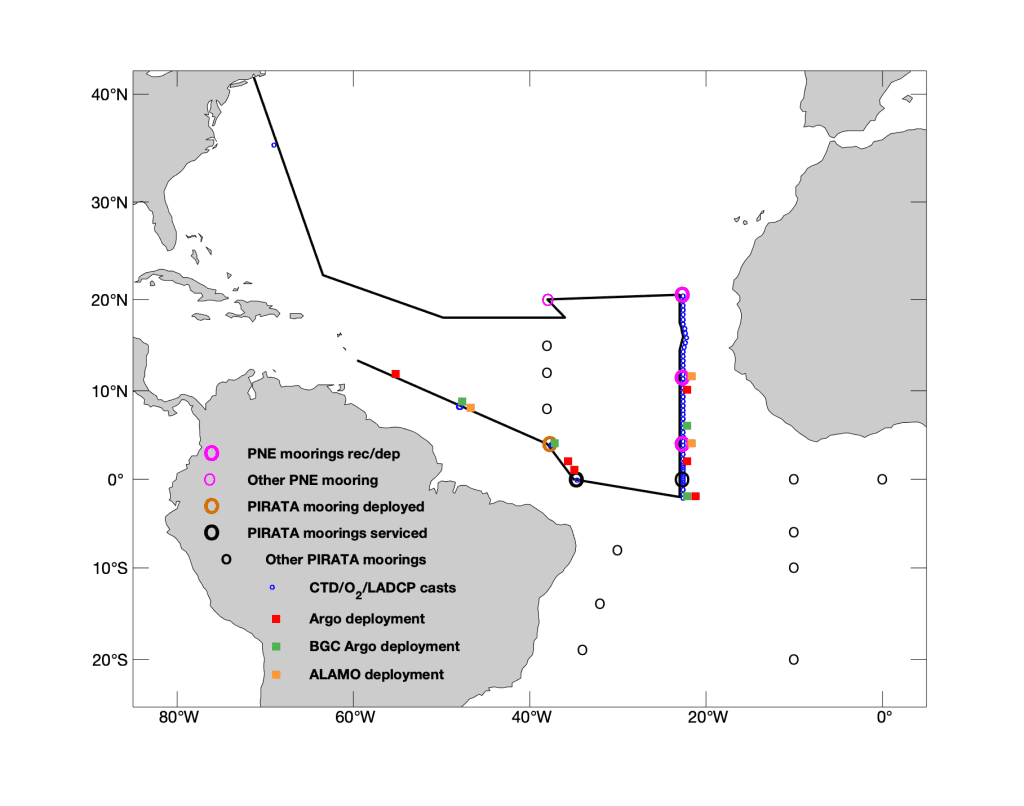
The 2022 PNE cruise took place from November 1 to December 9 on the R/V Ronald H. Brown, beginning in Bridgetown, Barbados and ending in Newport, RI. The chief scientist of PNE 2022 was Greg Foltz (NOAA/AOML). During the cruise, three of the four PIRATA Northeast Extension buoys were recovered and redeployed, a new mooring was deployed at the 4N, 38W Brazilian PIRATA site (the previous buoy had become unmoored and was adrift), the electronics tube on the 0, 35W Brazilian PIRATA buoy was replaced, and the rain gauge was replaced on the French PIRATA mooring at 0, 23W. 57 CTD casts were conducted, most along 23W. 6 Argo, 4 BGC Argo, and 3 ALAMO (small Argo) floats were deployed. AEROSE measured aerosol optical depth, launched 75 radiosondes, and collected dust samples from PIRATA moorings. Groups from Woods Hole and Fearless Fund collected samples of Sargassum for post-cruise analysis.
November 12 - December 19, 2021
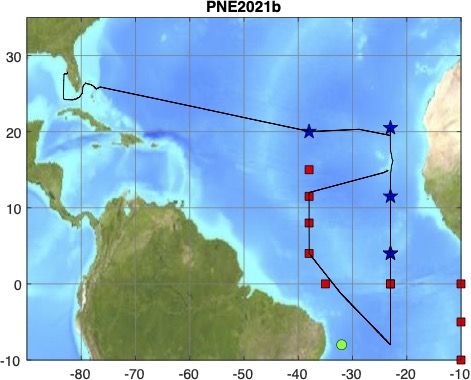
The FY2022 Prediction and Research Moored Array in the Tropical Atlantic (PIRATA) Northeast Extension (PNE) cruise began on November 12, 2021 in St. Petersburg, FL and ended on December 19, 2021 in Praia, Cape Verde. The chief scientist of PNE 2021b was Renellys Perez (NOAA/AOML). During the cruise, the NOAA/PMEL mooring team recovered and redeployed 4 PNE TFlex moorings, repaired a French PIRATA mooring at 0N, 23W, and recovered a Brazilian PIRATA mooring at 12N, 38W. The NOAA/AOML team conducted 70 hydrographic casts, deployed 15 surface drifting buoys, and deployed 11 Argo floats. For the first time, Tropical Atlantic Current Observations Study (TACOS current meters were deployed at the 20N, 38W PNE mooring. The Fearless Fund group collected samples of Sargassum for post-cruise analysis.
January 15 - February 24 , 2021
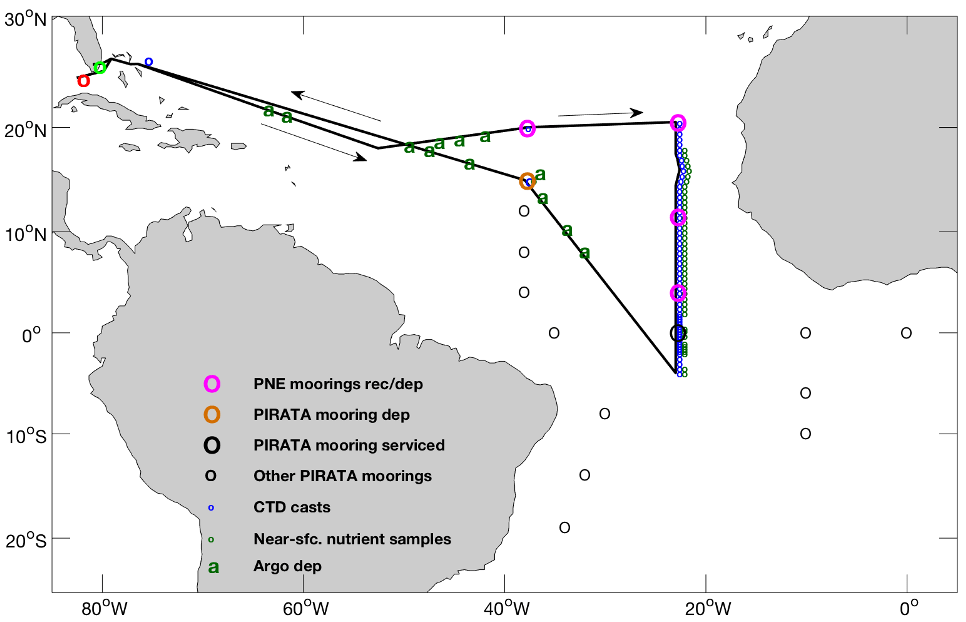
March 1 - March 29, 2019
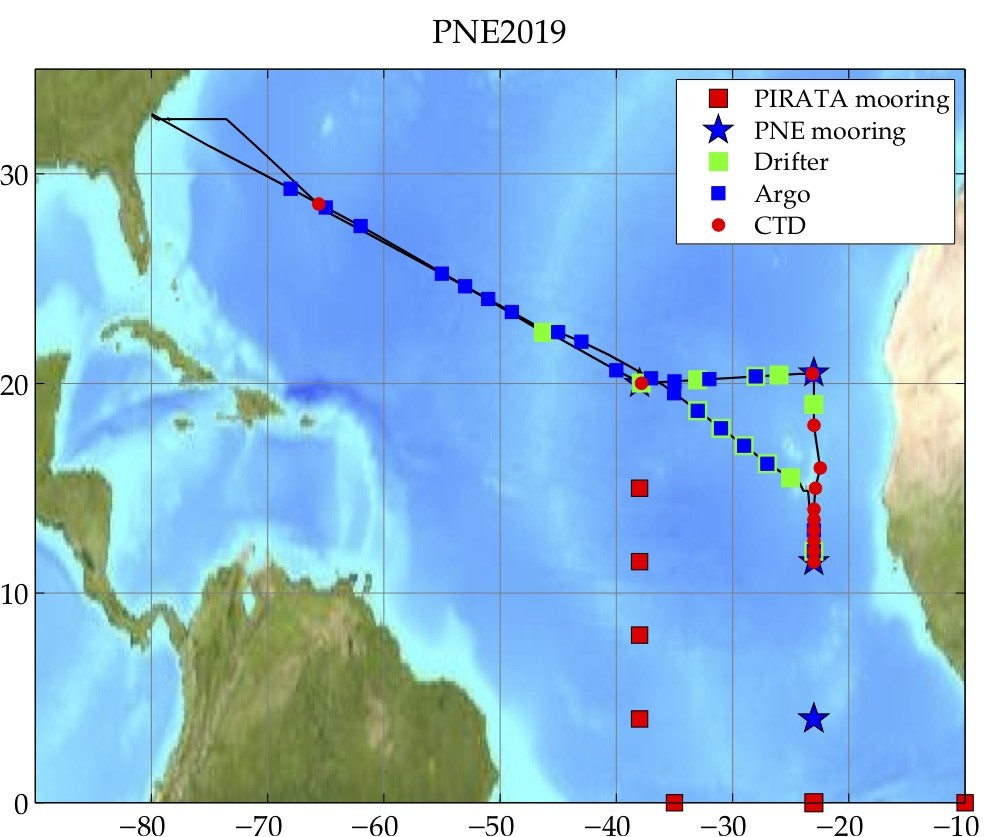
PNE2019 began on March 1, 2019 in Charleston, South Carolina on the NOAA R/V Ronald H. Brown, and ended early on March 29, 2019 in Charleston, South Carolina. Renellys Perez (NOAA/AOML) was the chief scientist. Science conducted during PNE2019 was greatly curtailed due to a reduction of almost two weeks at sea due to a series of delays/issues. Three moorings were serviced (20N, 38W; 20.5N, 23W; and 11.5N, 23W). The final mooring (4N, 23W) was serviced in May 2019 aboard the UNOLS R/V Thomas G. Thompson. Only 12 CTD casts were conducted due to limited time, and 14 surface drifters for NOAA’s Global Drifter program and 22 profiling floats for the Argo program were also deployed in areas with limited data coverage. AEROSE deployed 101 radiosondes and 8 ozonesondes during the cruise. Sargassum sightings were recorded by student volunteers.
March 7 - April 14, 2018
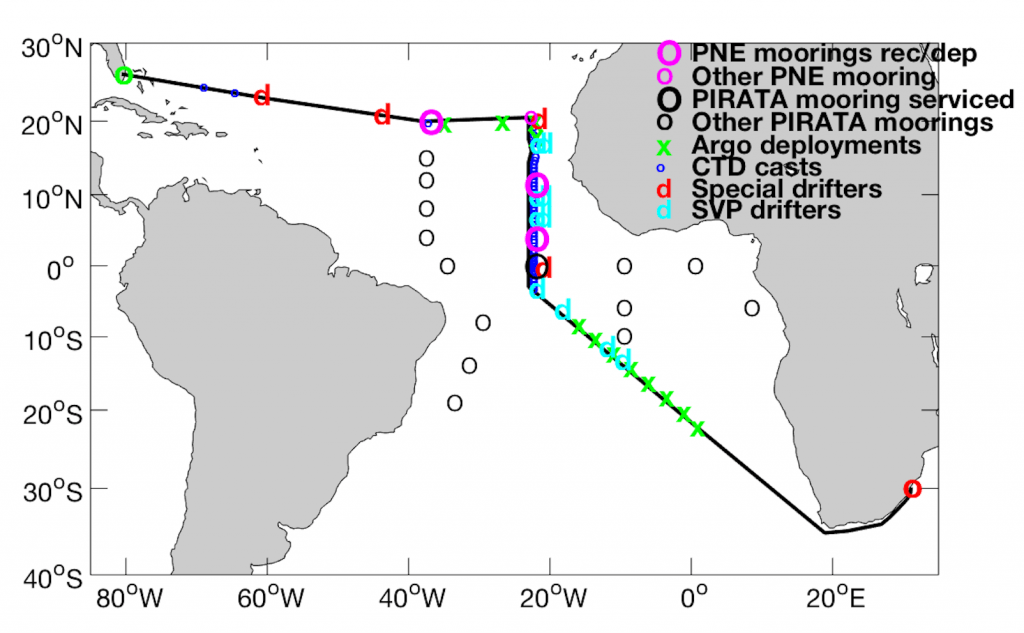
February 19 - March 25, 2017
February 19 – March 25
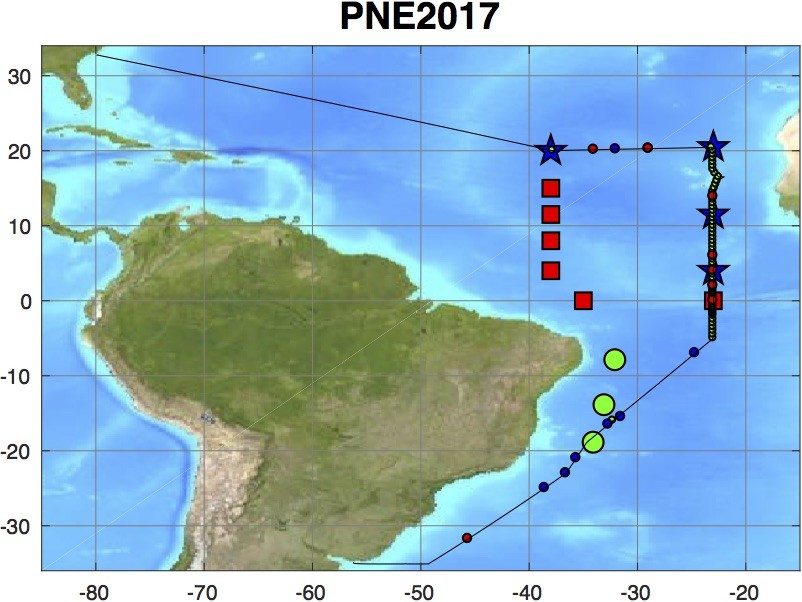
November 15 - December 14, 2015
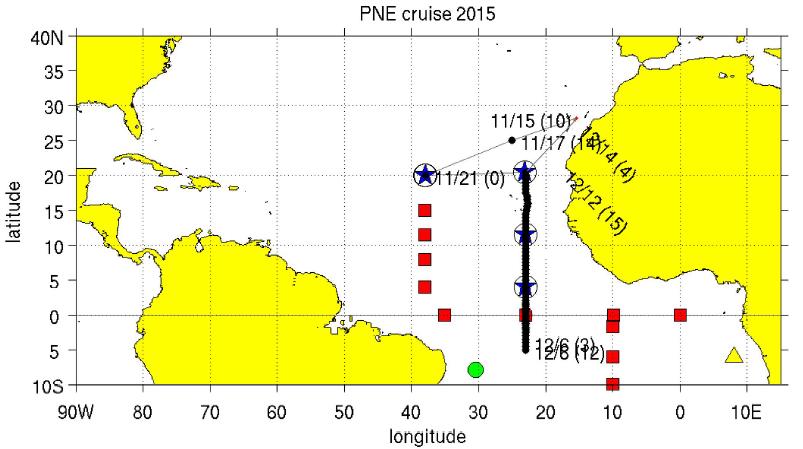
December 28 - February 12, 2014
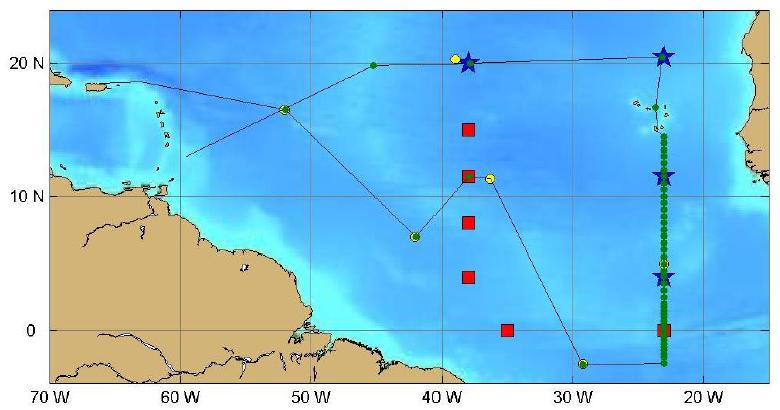
November 11 - December 8, 2013
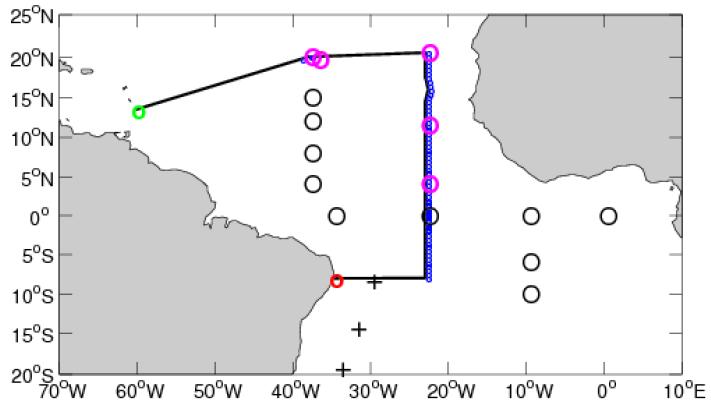
January 8 - February 13, 2013
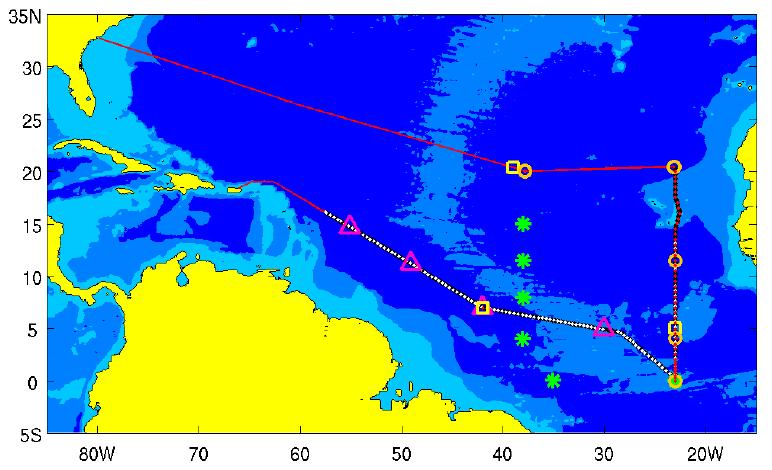
July 21 - August 21, 2011
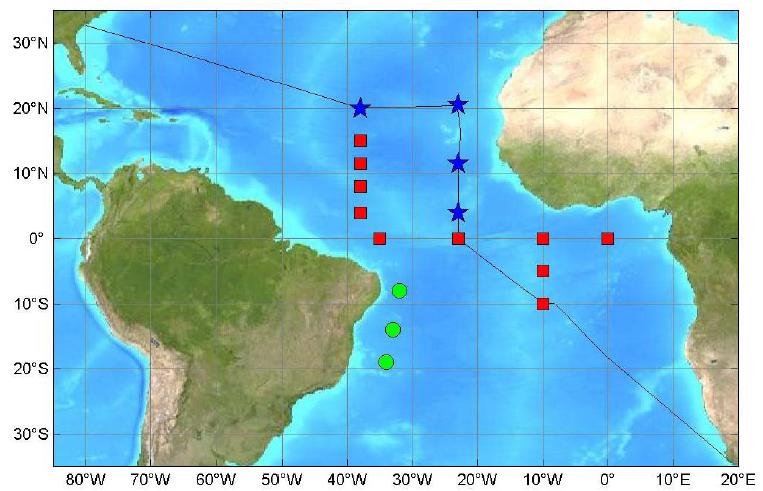
April 26 - May 22, 2010
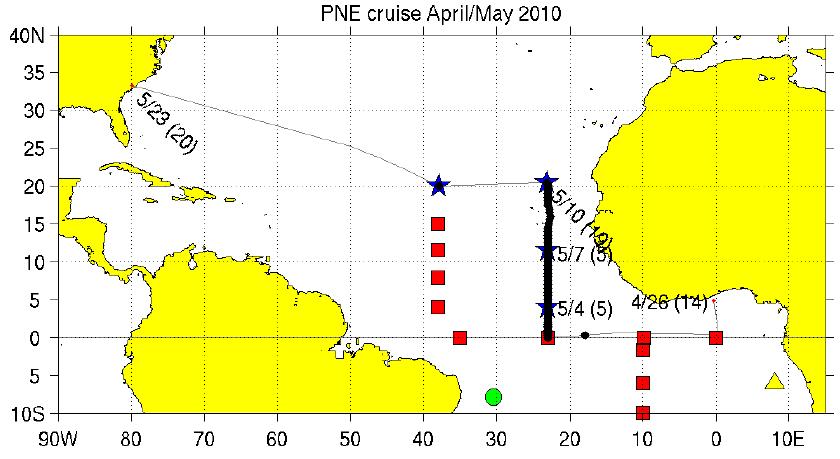
July 11- August 11, 2009
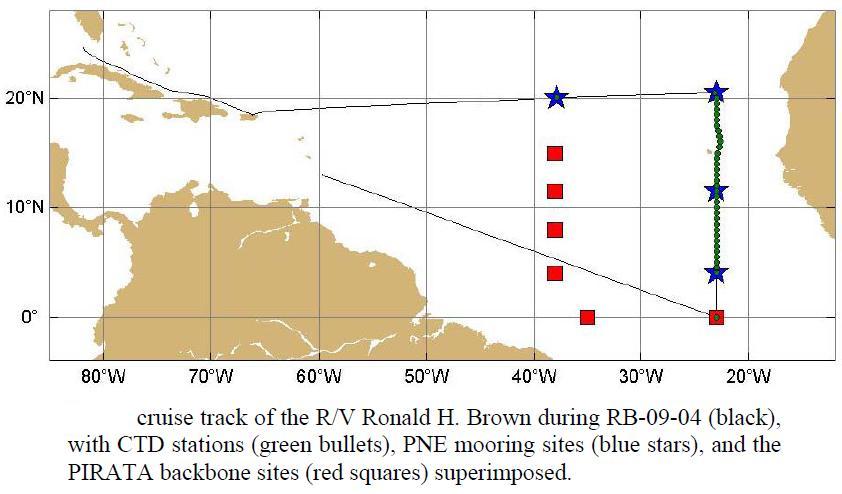
July 11- August 11, 2009



October 5 - October 18 & October 22 - November 5, 2008
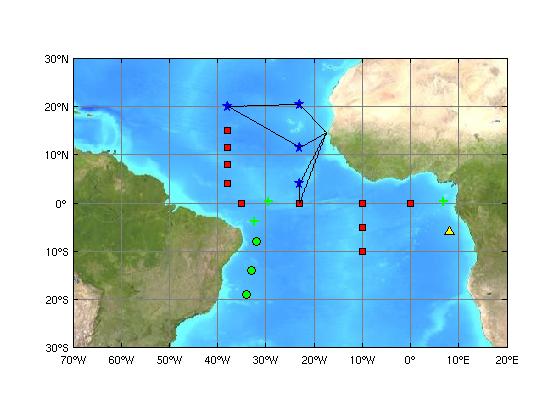

May 2 - May 29, 2007
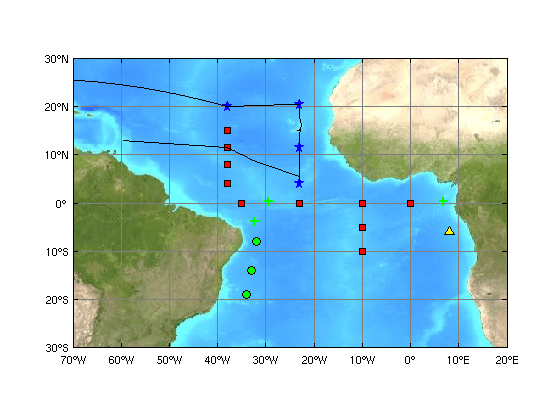

May 27 - June 18 & June 22 - July 16, 2006
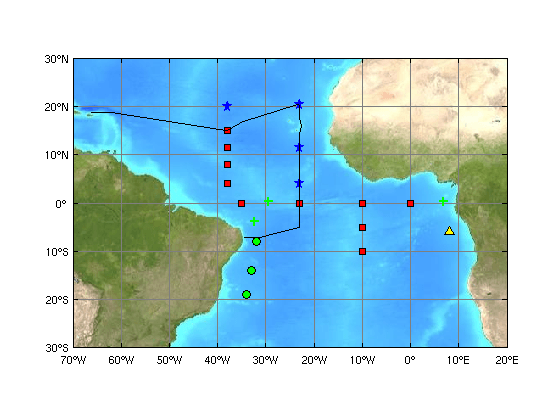

In the Literature
Driving Innovative Science with Data.
Our Contribution to Global Ocean Observing.
A PIRATA science publication is any publication that specifically mentions using PIRATA data, either mooring or cruise-related, or relies on these data in a significant manner. A paper using reanalysis or assimilation output that incidentally includes PIRATA data is not considered to be a PIRATA publication.
A PIRATA recent related and best practices publication is any that makes recommendations about best practices for tropical Atlantic observing and cites PIRATA as an example (e.g., sampling practices, quality control, real-time data sharing, governance, international collaboration, etc.) or uses PIRATA metadata for science or operations.
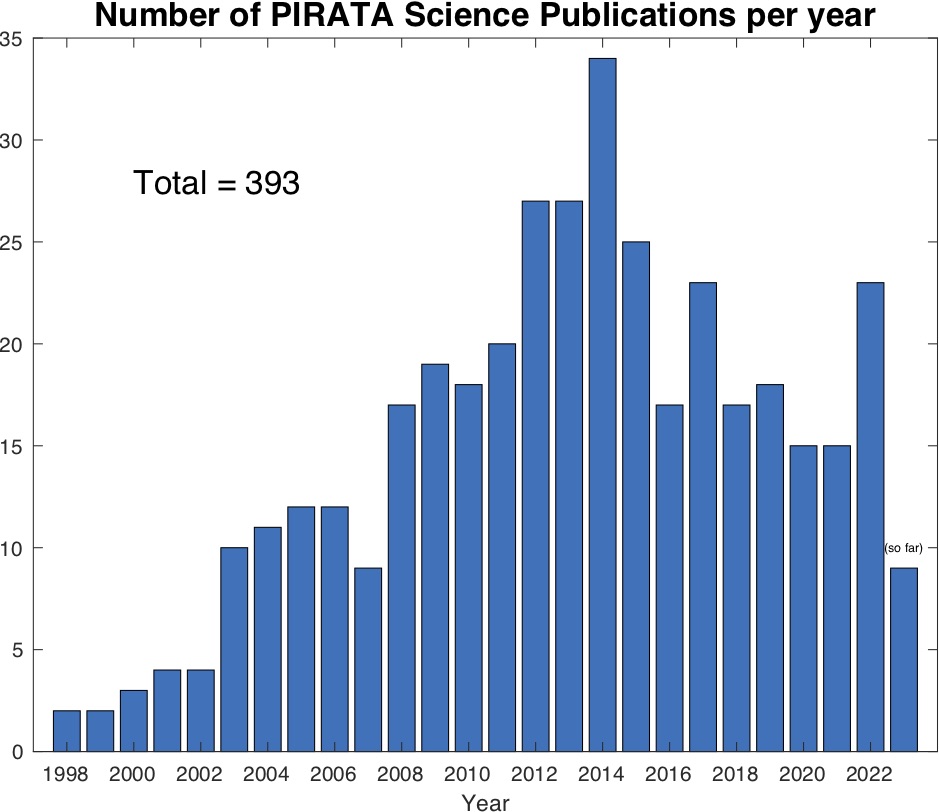

Featured Publication
Sharing Resources Delivers Results.
Expanding Reach Through Partnerships.
11
International universities and organizations have used PIRATA moorings and cruises to deploy scientific instruments and acquire measurements in the tropical Atlantic.
67%
Of our research, data sharing, and science is supported by Europe and South America.


